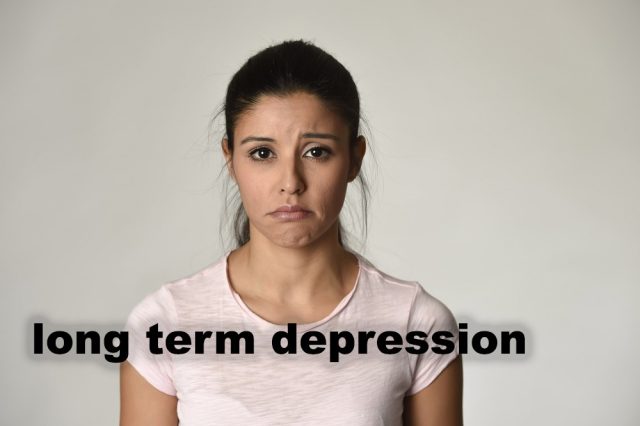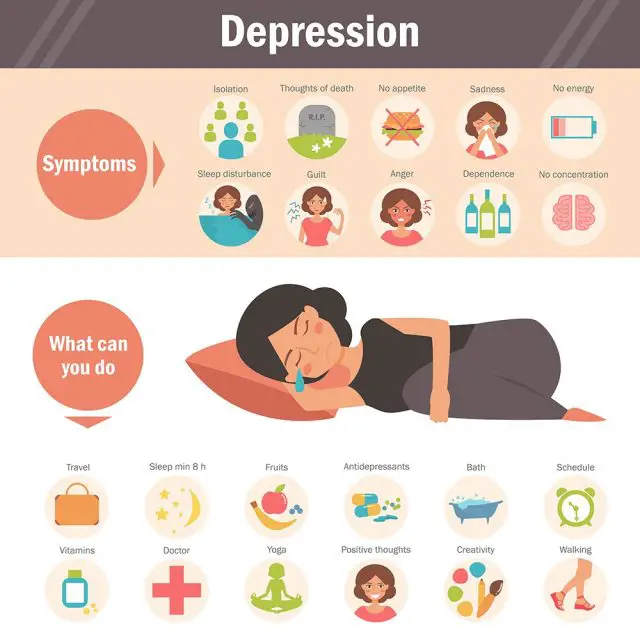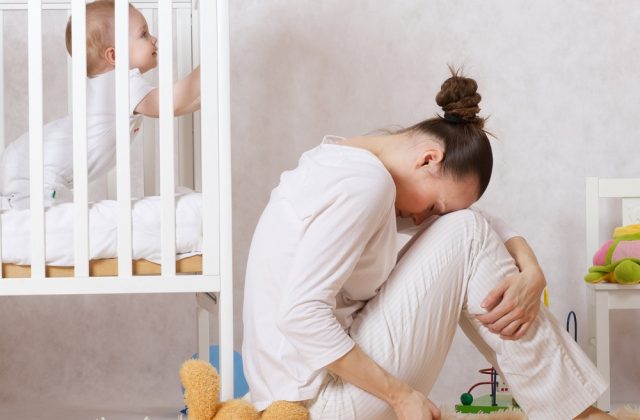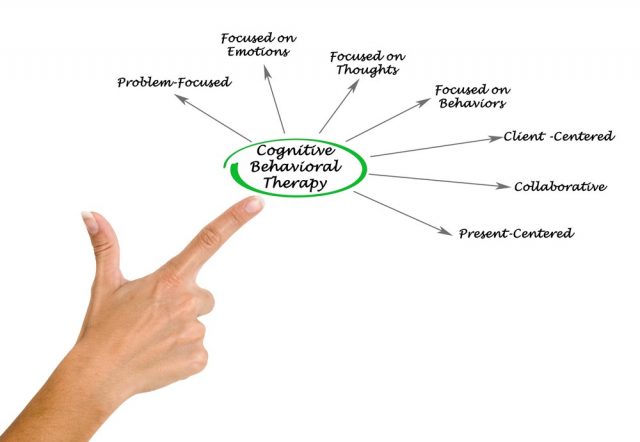Long Term Depression
In our mundane life, we have a tendency to experience multiple incidents of different attributes leading to a significant effect on our mood and mental state as a whole. Different shades of emotions are exhibited as a result.
However, sometimes, circumstances are such that we tend to be hurt or deeply saddened. But, the major mistake that one makes at this point of time is that he terms it into the classification of ‘depression’. Depression, unlike a feeling of sadness is not transitory in nature.
Depression is defined to be a state in which a condition of utter dejection sets in, particularly on the emotional front with exhibition of low self esteem coupled with desolation. A high degree of pessimism in general outlook is seen to be setting in on an individual suffering from depression.
However, symptoms of depression as a whole can take various manifestations depending on the intensity and level of incidence of it on someone. Also the span of time for which an individual has been in depression is crucial for diagnosis as the more the time span recorded, the greater the chance of the individual concerned of slipping into long term depression which may prove to be chronic.
The long term disability for depression and anxiety as a whole thus takes a twin toll at the well being of an individual as well as his key cognitive functioning. This particular form of mild yet chronic long term depression is named as Dysthymia, which later came to be known as persistent depressive disorder (PDD).
Signs and symptoms of Dysthymia
Having mentioned the manifestations and typology of depression or long term depression for that matter of fact, it is of utmost importance to be aware and careful about the signs and symptoms of long term depression or Dysthymia.
Although this form is of mild nature having lesser symptoms compared to more advanced and major depression, it has a particular innate tendency to show lingering yet prominent manifestations and people suffering from it can also be susceptible to windows of major depression attributes for periods of time, termed as ‘double depression’.
However, the symptoms are common for both dysthymia and major depression:
- Prevalent sadness and a feeling of emotional low almost all the time of a day is a common and regular symptom, coupled with loss of excitement in performing activities or absence of a mood of enjoyment and calmness.
- Sufferers exhibit a tendency to avoid social contact and shy out in such cases, trying to escape any sort of conversations. Even if a conversation occurs, the sufferers tend to engage in negative talks and nurture pessimism.
- Decision making capabilities come to a near standstill with the sufferer remaining perturbed in every situation with a regular tendency of avoidance of addressing any sort of problem. Insomnia steps in cases of early and mild depression. But if the intensity is greater, a tendency to oversleep on a regular basis is noticed.
- Anxieties, delusions, emptiness and hollowness in the mood patterns crop in. In acute cases, a tremendous quantum of a worthless feeling with no hope or expectations of revival gets to be exhibited and in worse cases, suicidal and other self harm tendencies gets inducted into the system of thoughts. This can prove to be detrimental in the case of a sufferer and thus such cases need to be dealt with high level of precision which in turn demands lot of care and patience.
- Also, the detrimental effects are not limited to the mental domain only but also have consequences on the physical front like digestive problems, irritable bowel disorders, a major loss in appetite and regular headaches.
Long term effects!
There are also some long term effects of depression although the severity of it is more or less at a minimal level.
If left untreated and undiagnosed, clinical depression can lead to serious consequences both on the cognitive and physical front:
- In worst case scenario, it may lead an individual to chronic drug dependency and addiction and resorting to more and more alcohol consumption. Substance abuse is a common fall out of undiagnosed dysthymia. A sufferer finds himself completely isolated from the mundanely occurrences and is left with a sense of utter perturbation and inability to use his logical power. The feeling of hopelessness simply engulfs him and his thoughts remain pre occupied with that feeling almost all the time.
- Undiagnosed clinical dysthymia takes a plunge at the physical health of an individual as well. It has regulating impact on metabolism and digestive power of the body by making them weaker and less efficient. Thus, sufferers of depression have trouble in consumption of food, primarily due to a loss in appetite in general and also experience trouble ingesting and digesting it.
- Also, a recurring effect is noticed in terms of achievement of adequate sleep with episodes of insomnia setting in due to a constant emotional and psychological turmoil which takes a jab at the performance credibility of an individual.
- More specifically, a regular hounding of a feeling of anxiety and claustrophobia seeps in. On the other hand, there are instances of energy deficiency pertaining to complete emotional draining, thus exhibiting a tendency of oversleeping and daytime fatigue on a large scale.
- Untreated depression may lead to weight gain in many situations, primarily due to less body movements as the sufferer does not feel like nor has the energy and agility to perform his otherwise mundane chores. This permits an accumulation of calories and fat which otherwise would have been burnt out. On the other hand, clinical depression may also lead to weight loss, since there is an inadequacy in intake of food and its metabolism.
Postpartum depression
Having discussed in a general sense, the symptoms and hazards that depression brings with it, one added specification in this aspect needs to be put forward in this aspect. Often, it is noticed, that there is a sense of crankiness, irritability and prolonged sadness in members of either sex after a child is born, particularly in the mother, for an onset period of time ranging from a week to a month after delivery. In clinical terms we call it postpartum depression or post natal depression.
However, if this syndrome remains persistent for a prolonged period of time and does not dwindle away with time, it is termed as long term postpartum depression. It basically unfolds in the initial stage as a disorder primarily on the mood front. The exact reason as to why it occurs is still to be known, and is probably a result of an intertwined meshwork of a number of hormonal, physical and psychological factors.
But the two primary or popular causes that leads to this are:
- Sometimes, prior experiences of psychological trauma, bipolarity or postpartum depression act as the basic stimulus for such problems.
- Along with that genetic history of the individual facing it is a crucial point of causality. Even if there are any complications during pregnancy or while delivery, this could have an impact on the basic psyche percolating into postpartum depression, which may occur any time within a year of delivery.
On the emotional front, the basic symptoms are mood swings of high intensity coupled with persistence of a low key sad feeling with little or no hope of progression and having trouble with connecting with the baby or caring for it.
The sufferer fails to be joyful about having the baby. Speaking from a behavioral sense, an individual with postpartum depression fails to be jovial about getting to work with a perpetual fatigue setting in coupled with low energy levels. A full-fledged or partial withdrawal from societal occurrences is observed along with a sense of low levels of libido and motivation.
Cognitively, the person fails in efficient decision making coupled with poor recalling capability of the memory and less concentration power. In worst case scenario, self harming or harm inflicted towards the baby or the partner of the sufferer is observed. An element of violence may step in at this stage. This may take a serious toll on the maternal and marital relationship of the sufferer.
Solutions
Having elaborated on the various aspects and dimensions of depression and its varied manifestations depending upon the intensity and duration of onset, a final point of diagnosis and mitigation must be rested:
- On the psychological front, different therapies are available that help an individual deal with clarity of thought patterns and stimuli and leads to improvement of cognitive and adaptive skills. Inter personal therapy is one such way in which personal relationship problems and patterns of vulnerability cropping up due to it is addressed and taken care of.

- Another such therapy is the Cognitive Behavior Therapy (CBT), where our thought (cognition) and action (behavior) are closely monitored and analyzed. A professional therapist is hired whose task is to find the factors resulting in the inability of a person to come out of depression or pushing him more into it.

- Lastly, medical treatments can also be resorted to, primarily that of antidepressant diagnosis and medication. Antidepressants are prescribed considering the severity coupled with drugs which help in stabilizing the mood and antipsychotic drugs.









